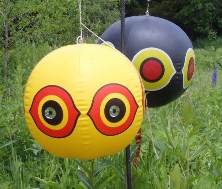Woodpeckers (in the Picidae family) are found throughout Nebraska, especially in association with forested areas. Many woodpeckers have feathers that are combinations of black, white, and red. One interesting feature of a woodpecker is its tail. Used as a prop, the stiffened tail is important for climbing and support as it pecks wood in search of insects. Another unusual feature are the woodpecker's feet. Each foot has four toes, with the 1st and 4th facing backward, and the 2nd and 3rd toes facing forward. This allows the woodpecker to hang on to tree limbs and trunks, and walk vertically up a trunk as well. Finally, the woodpecker has features that enable it to drum for communication and drill for food. Their bills are long and sharp, and they have long, sticky tongues for grabbling and pulling out insects.
Problems are uncommon, but occasionally woodpeckers damage wooden structures. At this time of year, they may be noticed pecking holes in wood siding, eaves, or trim boards. Woodpeckers prefer cedar and redwood siding. These birds have two reasons for their behavior. They may be locating insects which inhabit the wood (usually wasp larvae and beetles, not termites) or they may be creating cavities for roosting or nesting. You can find it, as well as other beautiful photos and information at the Nebraska Bird Library.
Because they depend on wood for food or shelter, woodpeckers' habits are hard to break. Merely filling the holes or shooing the birds away from a wooden building is not effective. Woodpeckers are classified as non-game birds and are protected by the Federal Migratory Bird Treaty Act. Exclusion and repelling are the available control methods. Decoys and models, such as snakes or owls, are ineffective. Visual repellents consisting of brightly colored reflective materials are very useful. Pie tins or commercially available products such as "Bird Scare Eyes" may be used. If the items move, the effect is enhanced. Hang them on strings if possible, so that the wind will cause motion.


